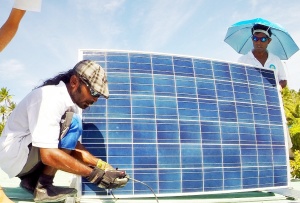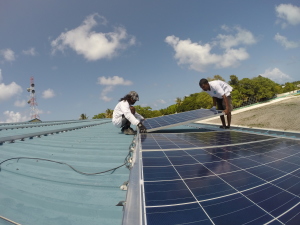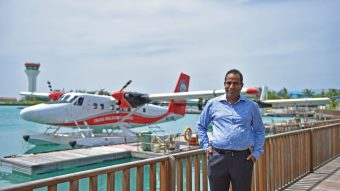
Renewable Energy for a Greener Future
[vc_row][vc_column width=”1/1″][vc_column_text el_class=”columns_2″]The trend for renewable energy investment worldwide peaked in 2011 and while investment, excluding large hydroelectric projects, declined in subsequent years, it came with a silver lining. The decline reflected a steep fall in solar photovoltaic (PV) systems, and in countries such as the United States, solar PV installations reached almost 5 Giga-watts in 2013, a dramatic rise from the previous year. China, however, was the dominant country in terms of investments in renewable energy last year, overshadowing the whole of Europe with USD 56 billion to Europe’s USD 46 billion. 2013 also witnessed a decrease in investment in developing nations.
 The Maldives has been slow in embracing renewable energy solutions despite its costly reliance on fossil fuels, particularly diesel, which caters to over 80 percent of the country’s energy demands. However, forays into renewable energy options were made two decades back. Among the earliest such projects in the country was the State Electric Company’s (STELCO) effort to install a solar PV system in Vaavu Atoll, in partnership with a Japanese company in 1995. “The project was designed but was discarded because it proved too costly,” said Dr. Ibrahim Nashid, Chairman of Renewable Energy Maldives (REM), a local company specializing in renewable energy solutions. This was followed by a series of pilot projects, one of which was establishing a solar PV system in Ari Atoll Mandhoo. “It was what they called a diesel-solar hybrid system and was installed around 2006,” Nashid said. “But it was a strange system; when the demand for electricity did not exceed the capacity of the PV system, then the electricity was provided via solar power. And if demand exceeded capacity, somebody would manually switch the power to diesel. But power consumption quickly outstripped the capacity of the solar PV system. Everybody had things like refrigerators and televisions that guzzled power. So what happened was the power system had to be switched to diesel frequently until finally the island community decided to abandon the solar PV system entirely and use the diesel generator.”
The Maldives has been slow in embracing renewable energy solutions despite its costly reliance on fossil fuels, particularly diesel, which caters to over 80 percent of the country’s energy demands. However, forays into renewable energy options were made two decades back. Among the earliest such projects in the country was the State Electric Company’s (STELCO) effort to install a solar PV system in Vaavu Atoll, in partnership with a Japanese company in 1995. “The project was designed but was discarded because it proved too costly,” said Dr. Ibrahim Nashid, Chairman of Renewable Energy Maldives (REM), a local company specializing in renewable energy solutions. This was followed by a series of pilot projects, one of which was establishing a solar PV system in Ari Atoll Mandhoo. “It was what they called a diesel-solar hybrid system and was installed around 2006,” Nashid said. “But it was a strange system; when the demand for electricity did not exceed the capacity of the PV system, then the electricity was provided via solar power. And if demand exceeded capacity, somebody would manually switch the power to diesel. But power consumption quickly outstripped the capacity of the solar PV system. Everybody had things like refrigerators and televisions that guzzled power. So what happened was the power system had to be switched to diesel frequently until finally the island community decided to abandon the solar PV system entirely and use the diesel generator.”
Renewable energy projects on the islands of Kondey and Uligamu were also unsuccessful; people expected a dramatic fall in the price of electricity. The problem with these projects according to Nashid was that they did not gain social acceptability.
Nashid’s company REM was awarded a power purchase agreement (PPA) with STELCO to provide solar energy. REM began installing systems on six islands in Male’ atoll; Vilingili, Kaashidhoo, Guraidhoo, Thulusdhoo Himmafushi and Maafushi. A total of 652 kilowatts was spread among these islands. The first system was installed in early 2012 and it marked the fruition of country’s first power purchase agreement, whereby the energy produced by the systems would be sold to STELCO. “Our rate was USD 25 cents per kilowatt hour,” Nashid said. “STELCO could then mark it up and sell it off to consumers.”
Moreover, in May this year, the Japanese International Cooperation Agency (JICA), the Japanese Government’s bilateral donor agency, completed a USD 11 million project that saw the installation of solar panels in twelve government buildings. This project is expected to generate some 700 kilowatts of clean energy.
Our perception of renewable energy needs to change, Nashid believes; it needs to be viewed through an economic lens rather than an environmental one. “We spent over 400 million dollars last year on fuel,” he said. “If we could even save 10 percent of that, that would boost the healthcare budget, or the education budget. The issue is not an environmental one, but an economic one, and one about energy security. What happens if the oil carrier is delayed by three weeks? The country would come to a standstill.”
Most of the country’s power is consumed by resorts where they house their own generators. In 2010, the installed capacity in resorts totaled 53 megawatts. “That [the resorts] is where we have to focus, in my opinion,” says Nashid. “That’s also where power wastage occurs on a great scale. Generally, resorts do not like to install solar PV on the roofs of the bungalows for aesthetic reasons. The only roofs for solar installation is the “back of the house” buildings. On average, space is available on these roofs for a 150kW system. And every kW of solar PV installed in the Maldives would save one litre of diesel every day.”
About 60 percent of a resort’s energy supply goes toward air conditioning while 20 percent is consumed by desalination. “Our question is this: how do we minimize the cost of diesel on a resort?” says Nashid. “We designed an approach whereby a resort that has an installed capacity of 1.5 Megawatts can make do with 600 Kilowatts, a reduction of more than 50 percent,” he says. The diesel generator’s waste heat is utilized for air conditioning via absorption chillers, which run on hot water produced by the waste heat of the generator. “A diesel engine’s maximum efficiency is 35 to 36 percent.” Nashid says. “You cannot increase its efficiency beyond that. Energy is wasted in the form of heat, smoke and sound. If one can harnesses the heat, and use it to minimize the load on the generators by using it via absorption chillers to power air conditioning then the size of the generator can be reduced.” The chemical in the absorption chiller do not require replenishing for a decade. The chiller itself has a lifetime of 25 years.
A typical five star resort in the Maldives consumes about 8,000 liters of diesel every day. “The cost of an absorption chiller, for instance, can be recovered in seven years.” Nashid says. “But the problem is that resorts don’t look at the lifecycle cost. They see only the installation cost, the capital expenditure.” Moreover, most resorts do not seem intent on reducing energy wastage; simple measures such as insulation, or keeping air conditioners in the comfort cooling zone; that is around 25 degrees Celsius, are overlooked. “If such wastage can be controlled, we can reduce diesel consumption by 60 percent.” In further reducing diesel consumption, resorts could opt for waste to energy solutions, which can go towards hot water and air conditioning. “Energy is not only electricity,” Nashid points out. “Heat is a good source of energy. In energy conversion, you can expect to lose about 20 percent [of energy] but you can eliminate this and create waste to energy in resorts, which also get a good volume to create such energy. There are 500 kilowatt and 1 megawatt solutions that are suited to resorts.” Resorts could also look into treating sewage and recycling water, if only to water the trees. “There is a mindset popular among resorts, that they will have to compromise on luxury and comfort if they were to shift to renewable energy,“ Nashid says. “But we’re saying no, that is not the case. Even the most decadent, luxurious property can be made compatible with renewable energy.”
 Nashid believes that resorts wanting to migrate to renewable energy solutions can benefit from the knowhow of local experts. “We have the knowhow, especially when it comes to solar PV systems,” he says. “We are more experienced and we can provide better solutions in a more cost effective manner. There is no need to go abroad seeking a solar PV solution.” In some instances like finding waste to energy solutions, equipment has to be sourced from abroad but there are local experts who can provide solutions.
Nashid believes that resorts wanting to migrate to renewable energy solutions can benefit from the knowhow of local experts. “We have the knowhow, especially when it comes to solar PV systems,” he says. “We are more experienced and we can provide better solutions in a more cost effective manner. There is no need to go abroad seeking a solar PV solution.” In some instances like finding waste to energy solutions, equipment has to be sourced from abroad but there are local experts who can provide solutions.
Some resorts however, have made small steps in moving towards renewable energy. “Some want to test the technology in small doses,” says Nashid. “For instance, one resort wants to light up their tennis court with solar power. And in heating water, some resorts have opted solar power long ago. So there is some acceptance of renewable energy by resorts.” Nashid believes that procedures like energy audits will help further the cause of clean energy. “International companies have procedures whereby energy audits have to be conducted as part of company audits. In Austria there’s a regulation that says all companies should complete energy audits by a certain date. So when such international companies operate resorts here there is a chance that things will get better on the renewable energy front. They will know that decreasing their cost of operations means greater returns.”
[/vc_column_text][/vc_column][/vc_row]





